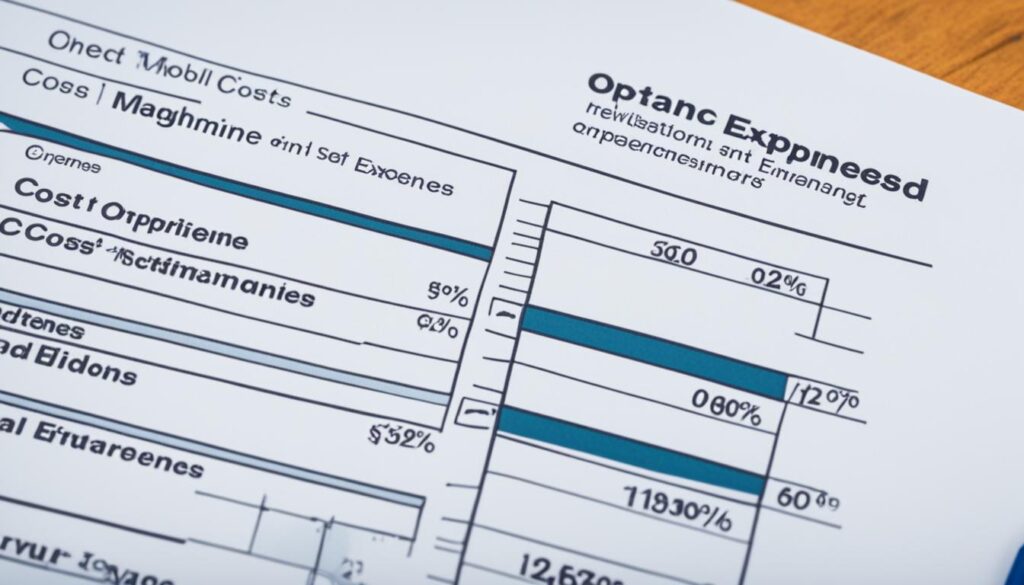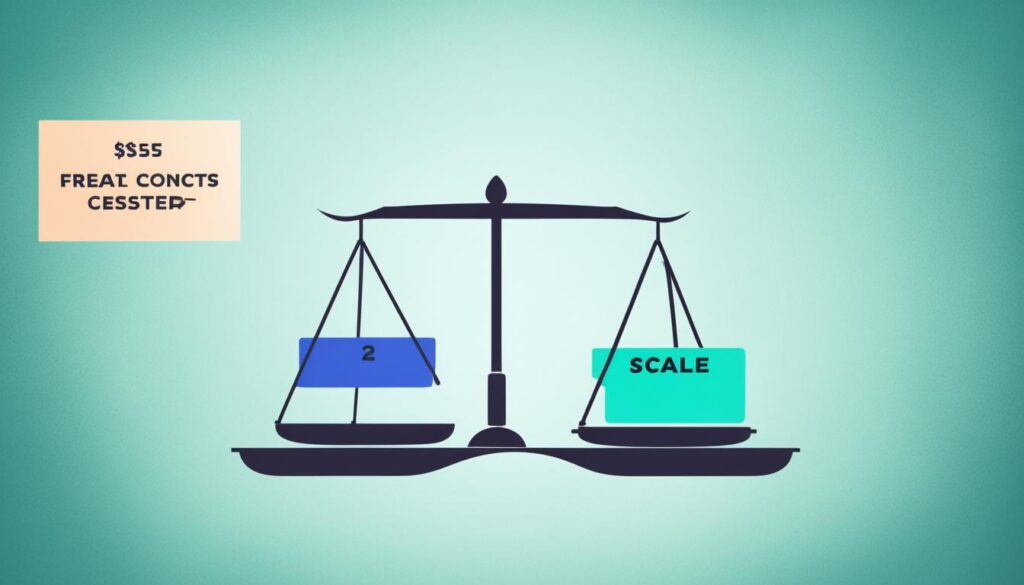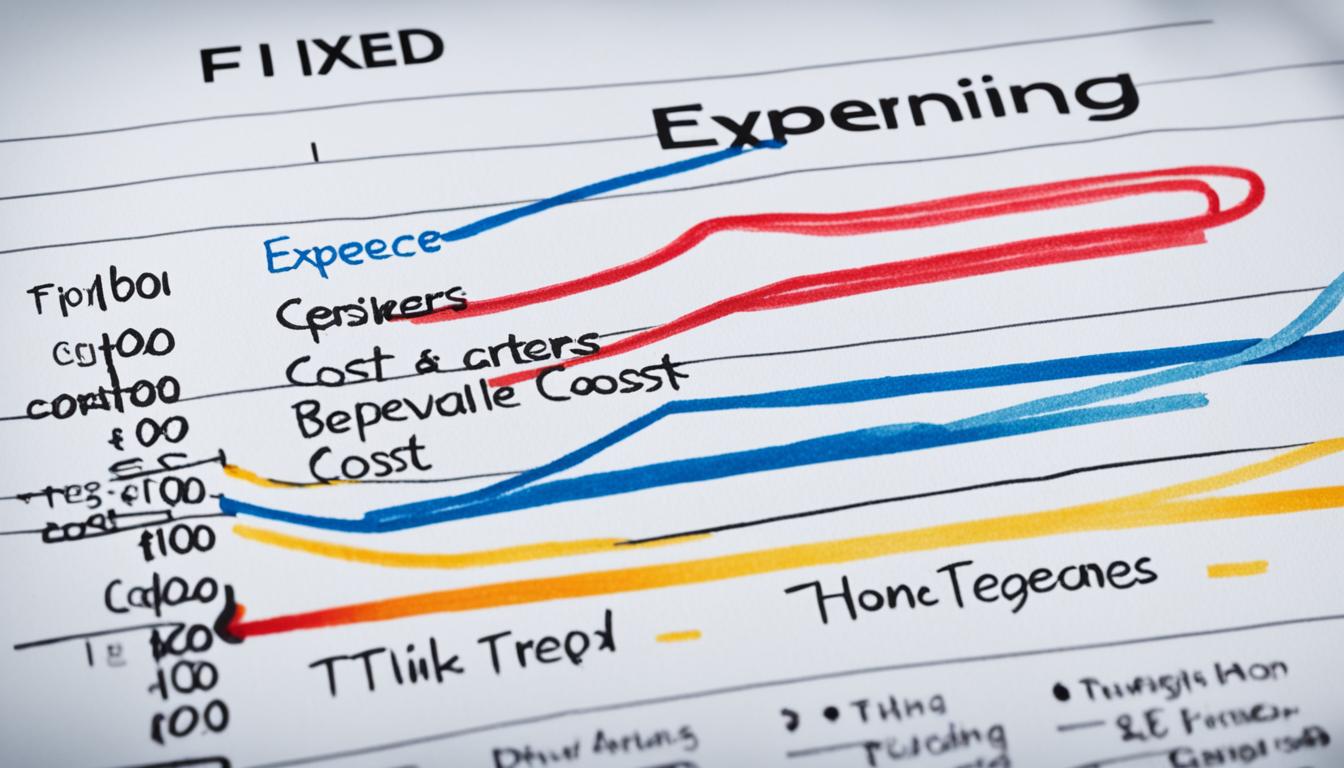Did you know that business expenses can be categorized into fixed and operating costs? These costs have a significant impact on the financial stability and profitability of a business. Understanding the difference between them is crucial for effective cost management and budgeting when running a business.
Key Takeaways:
- Operating expenses are an integral part of a business’s day-to-day operations.
- Fixed expenses remain constant regardless of output, while variable expenses change with production levels.
- Common operating expenses include compensation, sales and marketing expenses, accounting expenditures, insurance costs, property taxes and utilities, office supplies, and legal fees.
- Fixed costs provide stability and predictability, while variable costs can impact profitability based on production volumes.
- Managing fixed costs is crucial for financial stability and strategic decision-making.
Common Operating Expenses
Understanding the various types of business costs is essential for effective cost analysis and budgeting. When it comes to operating expenses, businesses encounter a range of expenditures that are fundamental to their day-to-day operations. By gaining a comprehensive understanding of these common operating expenses, businesses can make informed decisions and strategically allocate their resources.
Here are some of the most prevalent operating expenses that businesses typically incur:
| Expense Category | Description |
|---|---|
| Compensation | This includes salaries, wages, and benefits for employees. Compensation is a significant component of operating expenses for businesses. |
| Sales and Marketing Expenses | These expenses encompass advertising, sales materials, travel costs, and other expenditures related to sales and marketing efforts. |
| Accounting Expenditures | Businesses need to allocate funds for accounting services, including bookkeeping, tax preparation, and financial reporting. |
| Insurance Costs | Insurance expenses cover various types of coverage, such as general liability insurance, workers’ compensation insurance, and property insurance. |
| Property Taxes and Utilities | Businesses must factor in property taxes, as well as utility costs like electricity, water, and internet services. |
| Office Supplies | These expenses include essential supplies to maintain the office’s day-to-day operations, such as stationery, printer ink, and cleaning supplies. |
| Legal Fees | Legal matters often require professional assistance, leading to legal fees for consultation, contract drafting, and other legal services. |
The specific costs a business encounters can vary depending on factors such as the size of the organization and the industry it operates in. Nevertheless, these common operating expenses constitute a significant portion of a business’s overall costs.
By thoroughly considering and analyzing these expenses, businesses can develop more accurate budgets, allocate resources effectively, and optimize their financial performance.
Continue to Section 3: Fixed vs. Variable Operating Expenses
Fixed vs. Variable Operating Expenses
To effectively manage costs and create a robust budget, business owners need to understand the distinction between fixed and variable operating expenses. Fixed expenses, as the name suggests, remain constant regardless of production levels. These costs provide stability and predictability, allowing businesses to allocate resources efficiently. Common examples of fixed expenses include insurance premiums and property taxes. On the other hand, variable expenses fluctuate with production volumes. Utility costs are a typical example of variable expenses, as they vary depending on the level of output.
Understanding the difference between fixed and variable operating expenses is crucial for effective cost management. By analyzing and categorizing expenses properly, businesses can make informed decisions about budgeting and resource allocation. Fixed costs provide a solid foundation for financial planning, ensuring that essential expenses are covered regardless of business output. Variable costs, however, directly impact profitability, as they rise or fall based on production volumes.
Let’s take a closer look at the importance of managing fixed costs. A table below illustrates the impact of fixed costs on profitability at various production levels.
| Production Level | Sales | Fixed Costs | Variable Costs | Total Costs | Profit | Profit Margin |
|---|---|---|---|---|---|---|
| Low | 100 units | $10,000 | $2,000 | $12,000 | $8,000 | 8% |
| Medium | 500 units | $10,000 | $10,000 | $20,000 | $0 | 0% |
| High | 1000 units | $10,000 | $20,000 | $30,000 | -$10,000 | -10% |
The table clearly demonstrates the impact of fixed costs on profitability. At low production levels, fixed costs make up a smaller proportion of total costs, resulting in higher profits and profit margins. As production levels increase, fixed costs remain unchanged, leading to lower profits and eventually losses when variable costs exceed sales. Businesses must keep a close eye on both fixed and variable costs to ensure profitability at all production levels.
By understanding the importance of cost management and the impact of fixed costs, businesses can develop comprehensive budgets that account for both fixed and variable expenses. This knowledge empowers business owners to make informed decisions about resource allocation and adapt their strategies to changing market conditions. Effective cost management ultimately leads to improved financial stability, profitability, and long-term success.
In Summary
- Fixed expenses remain constant regardless of production levels, while variable expenses fluctuate with production.
- Understanding the difference between fixed and variable expenses is crucial for effective cost management and budgeting.
- Fixed costs provide stability and predictability, while variable costs can impact profitability based on production volumes.
Operating Expenses as Fixed Costs
In running a business, operating expenses are essential costs that must be considered. These expenses are categorized into two types: fixed costs and variable costs. Fixed operating expenses remain constant irrespective of the business output, providing stability and predictability to financial planning and decision-making.
Fixed operating expenses can include:
- Rent
- Salaries
- Insurance premiums
- Utility bills
To ensure financial stability and effective cost management, it is crucial for businesses to carefully assess and control these fixed expenses. By implementing budgeting techniques, businesses can allocate resources strategically and navigate through challenging economic conditions.
Managing fixed costs allows businesses to optimize their financial resources, improve profitability, and achieve long-term sustainability. It enables business owners to make informed decisions about resource allocation, investment opportunities, and overall financial planning.
Other Ways to Categorize Operating Expenses
When it comes to cost management and analysis for businesses, categorizing operating expenses in various ways can provide valuable insights. By organizing expenses based on their function, relation to revenue, timing, or priority levels, businesses can gain a deeper understanding of their expenditure patterns and identify areas for potential cost reduction.
One way to categorize operating expenses is by function. This involves grouping expenses based on their purpose within the business. For example, marketing expenses, such as advertising and sales materials, can be categorized separately from administrative costs, like office supplies and legal fees. By analyzing the different functions of expenses, businesses can assess the effectiveness of their spending and make informed decisions on resource allocation.
Another approach to categorization is based on the relationship between expenses and revenue. Some expenses may directly contribute to generating revenue, such as sales commission or production costs, while others may support revenue generation indirectly, like rent for a retail space. By categorizing expenses according to their revenue impact, businesses can prioritize investments that have the potential to generate the highest returns.
Timing is also an important factor to consider when categorizing operating expenses. Some expenses may be recurring monthly or annually, while others might be project-specific or occur irregularly. By tracking expenses based on their timing, businesses can better plan their cash flow, anticipate upcoming costs, and allocate resources effectively.
Finally, businesses can categorize operating expenses based on priority levels. By assigning different levels of importance or urgency to expenses, companies can prioritize resource allocation and ensure that essential expenditures are met first. For example, employee salaries and utility bills may be considered high-priority expenses, while discretionary spending on non-essential items may be lower priority.

“Categorizing expenses in different ways helps businesses identify areas for potential cost reduction without compromising productivity or quality standards.”
Advantages of Categorizing Operating Expenses
Categorizing operating expenses in these various ways offers several benefits for businesses:
- Identifying cost reduction opportunities: By analyzing expenses based on their function, relation to revenue, timing, or priority, businesses can identify areas with high spending and explore ways to reduce costs without negatively impacting productivity or quality.
- Optimizing resource allocation: Categorizing expenses allows businesses to allocate resources strategically. By understanding the impact of different types of expenses, companies can allocate funds to areas with the highest potential for growth and profitability.
- Improving budgeting and forecasting: Categorization helps businesses in budgeting and forecasting future expenses. By analyzing expense categories, businesses can make more accurate financial projections and identify any potential gaps or limitations in their budget plans.
- Enabling benchmarking and comparison: Categorizing expenses allows for benchmarking and comparison across different departments or industry standards. This enables businesses to identify areas where their expenses are higher or lower than average and make appropriate adjustments.
| Advantages of Categorizing Operating Expenses |
|---|
| Identifying cost reduction opportunities |
| Optimizing resource allocation |
| Improving budgeting and forecasting |
| Enabling benchmarking and comparison |
By analyzing and understanding these different categorization methods, businesses can gain valuable insights into their operating expenses, ultimately helping them make better-informed decisions on cost management and allocation of financial resources.
The Impact of Fixed Costs on Businesses
Fixed costs play a crucial role in shaping the financial success of businesses, particularly during periods of economic uncertainty. These costs remain unchanged, regardless of fluctuations in revenue, making them a constant factor that businesses must contend with. The impact of fixed costs on businesses is significant, as they can limit a company’s ability to make strategic investments or adapt swiftly to changing market conditions.
Managing fixed costs is essential for long-term profitability and resilience. It requires a careful evaluation of all expenses and finding ways to reduce unnecessary spending on fixed items, such as rent and utilities. By doing so, businesses can free up valuable resources that can be redirected towards innovation and growth, which are crucial for staying competitive in today’s dynamic business landscape.
“The ability to effectively manage fixed costs is a key competency for businesses seeking to navigate challenging economic conditions and achieve sustainable growth.” – John Smith, Financial Consultant
One way businesses can manage fixed costs is through a detailed cost analysis that identifies areas of potential savings. By understanding the breakdown of fixed expenses, businesses can identify opportunities to negotiate better rates, explore alternative service providers, or optimize resource allocation. This can lead to significant cost reductions and improved financial performance.
Benefits of Managing Fixed Costs:
- Improved Financial Stability: Managing fixed costs enables businesses to establish a strong financial foundation by reducing the impact of non-variable expenses. This stability provides a solid platform for future growth and strategic decision-making.
- Better Cash Flow Management: By optimizing fixed costs, businesses can better forecast and plan their cash flow, ensuring they have sufficient funds for day-to-day operations, investments, and contingency planning.
- Increased Operational Flexibility: Effective management of fixed costs allows businesses to allocate resources more efficiently, giving them the flexibility to respond to changing market conditions, invest in new opportunities, and adapt their business models as needed.
Overall, businesses that prioritize the management of fixed costs position themselves for long-term success. Understanding the impact of fixed costs and taking proactive steps to optimize them is essential for financial stability, growth, and the ability to weather uncertainties in the business environment.

Conclusion
Managing business expenditures and budgeting for fixed and operating costs are critical components of effective cost management in business. By understanding the distinction between fixed and operating costs, businesses can make informed decisions about cost allocation and resource optimization.
Operating expenses, encompassing both fixed and variable costs, are necessary for day-to-day operations. Fixed costs, such as rent, insurance premiums, and utility bills, provide stability and predictability, while variable costs fluctuate with production volumes. By carefully analyzing and categorizing these expenses, businesses can gain insights into their cost structure and identify areas for potential cost reduction.
Strategic budgeting plays a key role in managing fixed and operating costs. It allows businesses to allocate financial resources effectively, ensuring that essential expenses are covered while minimizing unnecessary spending. By controlling fixed costs through budgeting techniques, businesses can enhance their financial stability, make strategic investments, and maintain resilience in the face of economic uncertainties.
In conclusion, a comprehensive understanding of fixed and operating costs is crucial for businesses to optimize their financial resources, improve profitability, and ensure long-term sustainability. Through proactive cost management and strategic budgeting, businesses can navigate the complexities of expenditure management, make informed financial decisions, and achieve their growth objectives.
FAQ
What are fixed and operating costs when it comes to running a business?
Fixed costs are expenses that remain constant regardless of output, such as insurance and payroll. Operating costs are necessary expenses for day-to-day business operations and include both fixed and variable costs.
Can you explain the types of business costs that fall under operating expenses?
Some common operating expenses include compensation (salary, wages, benefits), sales and marketing expenses (advertising, sales materials, travel), accounting expenditures, insurance costs, property taxes and utilities, office supplies, and legal fees.
What is the importance of cost management for businesses?
Cost management is crucial for businesses as it allows them to optimize their financial resources, improve profitability, and ensure long-term sustainability. By carefully analyzing and managing expenses, businesses can make informed decisions about budgeting and resource allocation.
How do fixed and variable operating expenses differ?
Fixed operating expenses remain constant regardless of business output, such as rent, salaries, insurance premiums, and utility bills. Variable operating expenses fluctuate with production volumes, like utility costs. Understanding the difference between these two types of expenses is essential for effective cost management and budgeting.
Why is it important to manage operating expenses?
Managing operating expenses is important for financial stability and strategic decision-making. By carefully assessing and controlling these expenses through budgeting techniques, businesses can allocate resources effectively and optimize their overall costs.
Are there other ways to categorize operating expenses?
Yes, operating expenses can be categorized based on function, relation to revenue, timing, or priority levels. Categorizing expenses in different ways helps businesses identify areas for potential cost reduction without compromising productivity or quality standards.
What is the impact of fixed costs on businesses?
Fixed costs can have a significant impact on businesses, especially during times of economic uncertainty. These expenses remain constant regardless of revenue fluctuations and can limit a company’s ability to make strategic investments or adapt to changing market conditions. Managing fixed costs is crucial for long-term profitability and resilience.
What is the importance of understanding fixed and operating costs for effective cost management and budgeting?
Understanding fixed and operating costs is essential for effective cost management and budgeting in business. By carefully analyzing and managing these expenses, businesses can optimize their financial resources, improve profitability, and ensure long-term sustainability.


